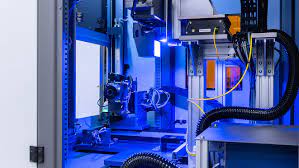There is a continuous process of change occurring in the industrial and construction industries, and laser welding is not an exception. Traditional welding techniques are known to be time-consuming, to call for a significant amount of physical effort, and to sometimes result in faults in the finished product. However, with the advent of laser welding driven by artificial intelligence (AI), an alternative product has emerged in the market currently. In this post we will discuss how artificial intelligence is reshaping the landscape of laser welding.
How are firms that specialize in welding technology using artificial intelligence?
Welding technology businesses are using the revolutionary potential of artificial intelligence in order to modernize laser welding in the industrial industry. This significant advancement in technology ushers in a new age of manufacturing efficiency, bringing us one step closer to factories that are completely self-sufficient and capable of continuously improving themselves. By incorporating artificial intelligence into the welding process, TIG welding machine manufacturers are able to reduce the amount of interference from the outside world, cut down on production time and waste, and improve the quality of laser welding applications, particularly in the area of electric mobility technologies. When welding high-absorption materials like steel and nickel, the keyhole tends to stay constant throughout the process. This feature makes it possible for laser welding to reach greater processing rates, decreased distortion, and improved weld quality.
Advantages of laser welding over traditional welding methods
- Welders are able to make elaborate and delicate welds with the maximum precision when they rely on a laser beam that is fully focused.
- In addition to this, laser welding provides an extraordinary degree of adaptability. The use of this technique is effective on a broad variety of materials, including metals, polymers, and even materials that are not comparable to one another.
- Laser welds are very clean by nature. In most cases, they are so clean that they do not need to be ground again, which results in a considerable savings in the expenses associated with post-processing such materials.
- It is possible to include modern laser welding systems into complex robotics and computer numerical control (CNC) systems. This integration enables exact control of welding parameters and accuracy.
In conclusion, laser welding offers a multitude of benefits that are advantageous in comparison to conventional welding techniques. Because of its preciseness, speed, variety, clean finish, and automation possibilities, it is an important technology for companies who are looking to boost their production and achieve the greatest possible quality that can be achieved via welding.
How are firms that specialize in welding technology using artificial intelligence?
- Welding technology businesses are using the revolutionary potential of artificial intelligence in order to modernize laser welding in the industrial industry. This significant advancement in technology ushers in a new age of manufacturing efficiency, bringing us one step closer to factories that are completely self-sufficient and capable of continuously improving themselves.
- By incorporating artificial intelligence into the welding process, producers of spot welding machines are able to reduce the amount of interference from the outside world, cut down on production time and waste, and improve the quality of laser welding applications, particularly in the area of electric mobility technologies.
- Additionally, artificial intelligence algorithms have the ability to learn from previous data and trends, which enables the system to improve over time. This indicates that the artificial intelligence system grows increasingly proficient at anticipating ideal welding settings with each welding operation, hence minimizing the quantity of human intervention that is required.
- Another significant area in which artificial intelligence is contributing to the revolution in laser welding is in the identification of defects and the management of quality. Using artificial intelligence algorithms, weld photos may be analyzed and compared to present criteria in order to discover any defects or inconsistencies that may be present.
Challenge associated with laser welding
- When compared to thermal welding techniques, which often result in weld seams that are broader and shallower, the high aspect ratio of laser welding also results in a possibility for component deformations.
- There is a little disadvantage associated with the fact that laser welding is characterized by its accuracy. This is due to the fact that if the component being worked on is not properly fitted, the quality of the welding will suffer significantly.
- The initial purchase cost of laser installations is twice or even three times more than the cost of purchasing conventional systems.
In spite of these challenges, TIG welding machine manufacturers that are attempting to electrify their products are increasingly turning to unique laser-based materials processing. Because they customize the process parameters for each application, they are able to keep up with the manufacturing rate. This allows them to maintain keyhole reliability and weld quality.

